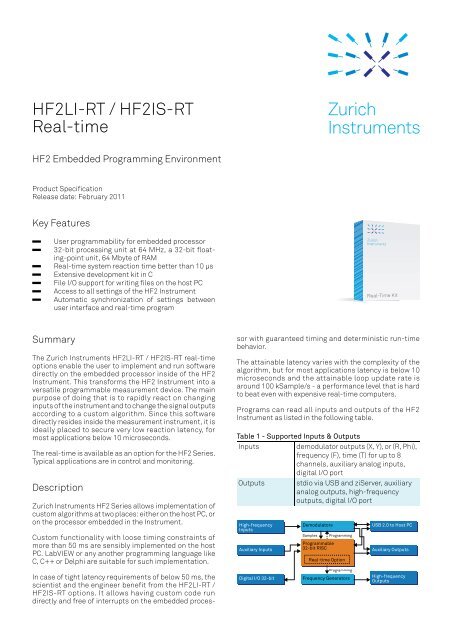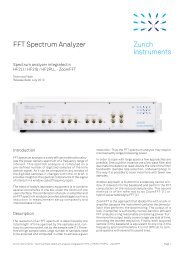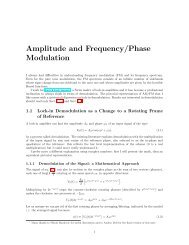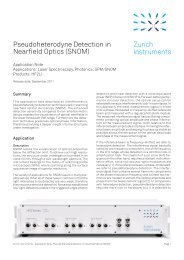Download Leaflet - Zurich Instruments
Download Leaflet - Zurich Instruments
Download Leaflet - Zurich Instruments
You also want an ePaper? Increase the reach of your titles
YUMPU automatically turns print PDFs into web optimized ePapers that Google loves.
HF2LI-RT / HF2IS-RT<br />
Real-time<br />
<strong>Zurich</strong><br />
<strong>Instruments</strong><br />
HF2 Embedded Programming Environment<br />
Product Specification<br />
Release date: February 2011<br />
Key Features<br />
• User programmability for embedded processor<br />
• 32-bit processing unit at 64 MHz, a 32-bit floating-point<br />
unit, 64 Mbyte of RAM<br />
• Real-time system reaction time better than 10 μs<br />
• Extensive development kit in C<br />
• File I/O support for writing files on the host PC<br />
• Access to all settings of the HF2 Instrument<br />
• Automatic synchronization of settings between<br />
user interface and real-time program<br />
Summary<br />
The <strong>Zurich</strong> <strong>Instruments</strong> HF2LI-RT / HF2IS-RT real-time<br />
options enable the user to implement and run software<br />
directly on the embedded processor inside of the HF2<br />
Instrument. This transforms the HF2 Instrument into a<br />
versatile programmable measurement device. The main<br />
purpose of doing that is to rapidly react on changing<br />
inputs of the instrument and to change the signal outputs<br />
according to a custom algorithm. Since this software<br />
directly resides inside the measurement instrument, it is<br />
ideally placed to secure very low reaction latency, for<br />
most applications below 10 microseconds.<br />
The real-time is available as an option for the HF2 Series.<br />
Typical applications are in control and monitoring.<br />
Description<br />
<strong>Zurich</strong> <strong>Instruments</strong> HF2 Series allows implementation of<br />
custom algorithms at two places: either on the host PC, or<br />
on the processor embedded in the Instrument.<br />
In case of tight latency requirements of below 50 ms, the<br />
scientist and the engineer benefit from the HF2LI-RT /<br />
HF2IS-RT options. It allows having custom code run<br />
directly and free of interrupts on the embedded processor<br />
with guaranteed timing and deterministic run-time<br />
behavior.<br />
The attainable latency varies with the complexity of the<br />
algorithm, but for most applications latency is below 10<br />
microseconds and the attainable loop update rate is<br />
around 100 kSample/s - a performance level that is hard<br />
to beat even with expensive real-time computers.<br />
Programs can read all inputs and outputs of the HF2<br />
Instrument as listed in the following table.<br />
Table 1 - Supported Inputs & Outputs<br />
Inputs<br />
demodulator outputs (X, Y), or (R, Phi),<br />
frequency (F), time (T) for up to 8<br />
channels, auxiliary analog inputs,<br />
digital I/O port<br />
Outputs<br />
stdio via USB and ziServer, auxiliary<br />
analog outputs, high-frequency<br />
outputs, digital I/O port<br />
Custom functionality with loose timing constraints of<br />
more than 50 ms are sensibly implemented on the host<br />
PC. LabVIEW or any another programming language like<br />
C, C++ or Delphi are suitable for such implementation.
Software<br />
The HF2LI-RT / HF2IS-RT options can be programmed<br />
based on Windows XP, Vista, and on Linux computers. The<br />
delivered package includes:<br />
• A C compiler that generates code that can be<br />
downloaded to the embedded processor inside the<br />
HF2 Instrument<br />
• ANSI C standard stdlib library for general purpose<br />
functions like memory allocation, process control,<br />
conversions and others<br />
• ANSI C standard math library for mathematical<br />
operations<br />
• ANSI C standard stdio library for functions and<br />
types used for various input and output operations,<br />
in particular files<br />
• Support for the API for communication between<br />
software running on the host computer and<br />
real-time program (ziAPI)<br />
• Programmer and host computer tools<br />
Table 2 - Software Implementation Comparison<br />
Algorithm<br />
implementation<br />
on<br />
host computer<br />
Programming language LabVIEW, C,<br />
C++,<br />
Delphi, etc.<br />
Ease of implementation + -<br />
Complex algorithms + =<br />
Debugging + -<br />
Latency - ++<br />
User friendliness = +<br />
Example Applications<br />
Embedded<br />
processor<br />
with<br />
HF2LI-RT /<br />
HF2IS-RT<br />
The applications include system control in scanning<br />
probe microscopy, PLL applications, multi-frequency and<br />
MEMS oscillations, periodic measurements, and<br />
high-throughput measurements.<br />
C<br />
Table 3 - Application Comparison<br />
Algorithm<br />
implementation<br />
on<br />
host computer<br />
PLL with time constant > 50 x<br />
ms<br />
PLL with time constant < 50<br />
ms<br />
Oscillation control for MEMS<br />
Q > 100<br />
Spectral or octave analysis x<br />
Multi-mode oscillators<br />
Spectral analysis with<br />
real-time trigger and latency<br />
< 50 ms<br />
Phased array recording<br />
x<br />
High-throughput<br />
measurements /<br />
semiconductor<br />
characterization<br />
Specifications<br />
Table 4 - Processor Details<br />
processor type<br />
processor floating point unit<br />
processor performance<br />
processor memory<br />
processor cache<br />
Embedded<br />
processor<br />
with<br />
HF2LI-RT /<br />
HF2IS-RT<br />
x<br />
x<br />
x<br />
x<br />
MicroBlaze, 32-bit RISC<br />
processor with Harvard<br />
architecture (separate<br />
code and data memory<br />
buses)<br />
32 bit in hardware<br />
64 MHz<br />
64 MB<br />
16 kB instruction, 16 kB<br />
data<br />
Table 5 - Timing & Performance<br />
typical latency (depends on 10 μs<br />
complexity of algorithm)<br />
get/set parameter rate 500 kHz<br />
PLL loop rate (example) 120 kSample/s<br />
PID loop rate (example) 120 kSample/s<br />
x<br />
<strong>Zurich</strong> <strong>Instruments</strong><br />
Technoparkstrasse 1<br />
CH-8005 <strong>Zurich</strong><br />
Switzerland<br />
Phone +41-44-5150410<br />
Fax +41-44-5150419<br />
Email info@zhinst.com<br />
Web www.zhinst.com<br />
About <strong>Zurich</strong> <strong>Instruments</strong><br />
Technology-leader <strong>Zurich</strong> <strong>Instruments</strong> (ZI) designs and manufactures high performance dynamic signal<br />
analysis instruments for advanced scientific research and leading industrial applications. ZI products include<br />
lock-in amplifiers, instruments for electrical impedance spectroscopy, and application specific pre-amplifiers.<br />
Headquartered in <strong>Zurich</strong>, Switzerland, ZI is a technology spin-off from the Swiss Federal Institute of Technology<br />
(ETH <strong>Zurich</strong>). ZI customers are scientists and engineers in leading research labs and organizations worldwide.<br />
Disclaimer<br />
The contents of this document are provided by <strong>Zurich</strong> <strong>Instruments</strong>, 'as is'. ZI makes no representations nor<br />
warranties with respect to the accuracy or completeness of the contents of this publication and reserves the<br />
right to make changes to the specification at any time without notice. All trademarks are the property of their<br />
respective owners.





